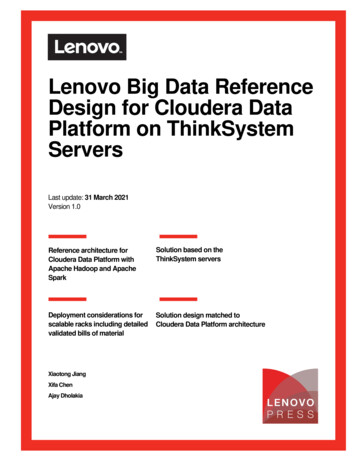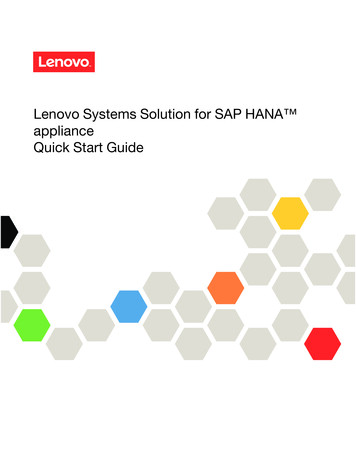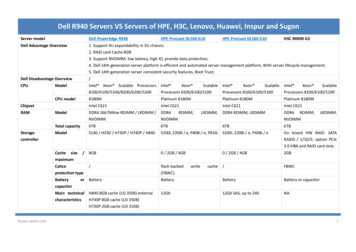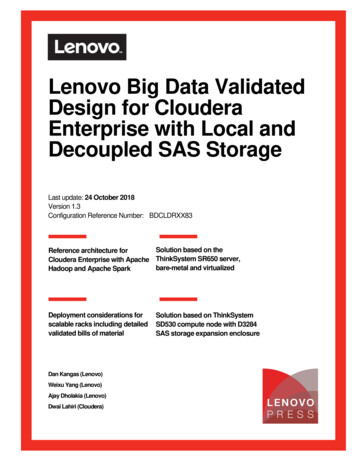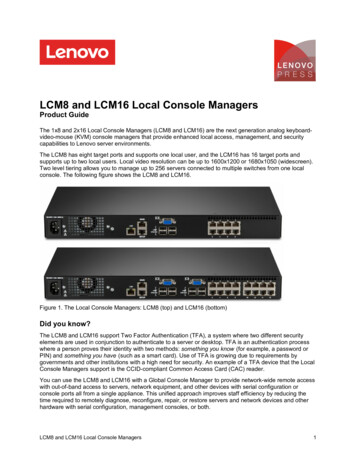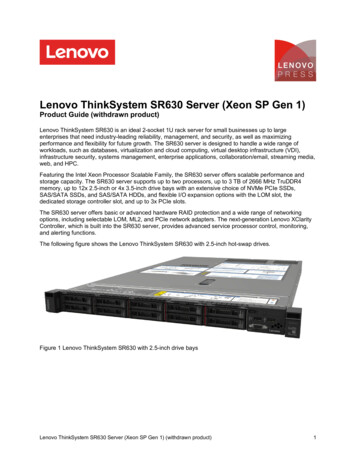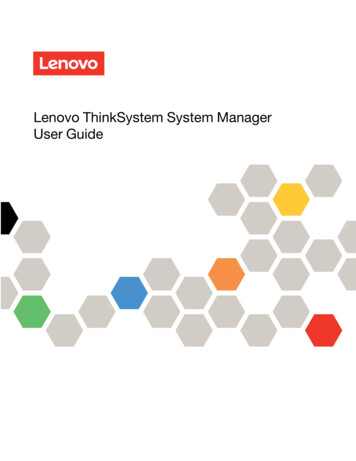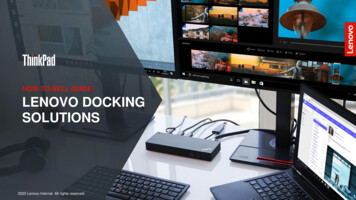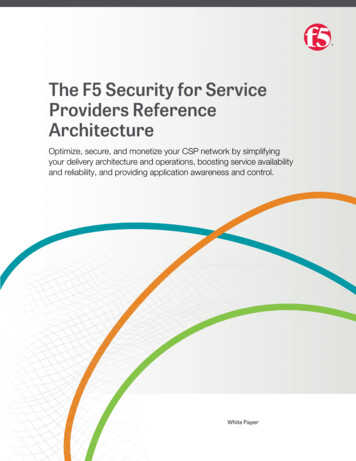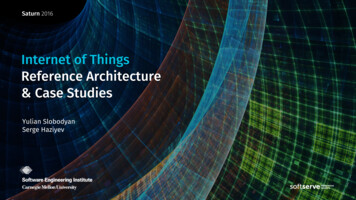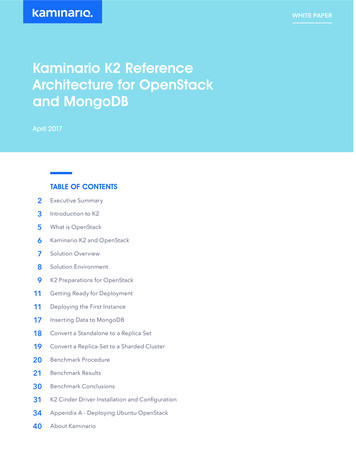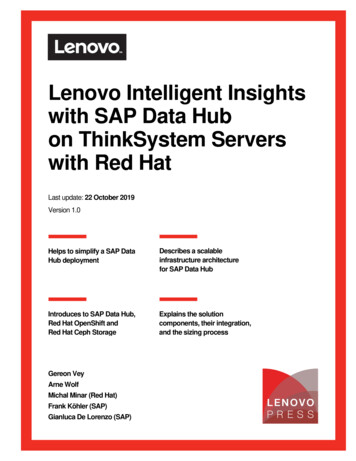
Transcription
Lenovo Intelligent Insightswith SAP Data Hubon ThinkSystem Serverswith Red HatLast update: 22 October 2019Version 1.0Helps to simplify a SAP DataHub deploymentDescribes a scalableinfrastructure architecturefor SAP Data HubIntroduces to SAP Data Hub,Red Hat OpenShift andRed Hat Ceph StorageExplains the solutioncomponents, their integration,and the sizing processGereon VeyArne WolfMichal Minar (Red Hat)Frank Köhler (SAP)Gianluca De Lorenzo (SAP)Click here to check for updates
Table of Contents1Introduction . 12Business problem and business value. 22.1Business problem . 22.2Business value . 22.3Business Value of the Lenovo Solution for SAP Data Hub. 33Requirements . 43.1Functional requirements . 43.2Non-functional requirements . 54Architectural overview . 65Component model . 75.1SAP Data Hub . 75.1.1Tenant Applications and Services . 75.1.2Vora Database . 85.1.3System Management . 85.1.4Diagnostics . 85.1.5SAP HANA . 85.2Kubernetes. 85.2.1Kubernetes Overview . 85.2.2Red Hat OpenShift . 95.2.3Private Docker Registry . 95.3Ceph Storage . 105.4Optional components . 115.4.16Hadoop .11Operational model . 126.1Hardware components . 126.1.1Servers . 136.1.2Network Switches . 176.2Logical Components . 186.2.1iiSAP Data Hub Application . 19Lenovo Intelligent Insights with SAP Data Hub on ThinkSystem Servers
76.2.2Solution Storage Layer . 196.2.3Optional Hadoop cluster . 19Deployment considerations . 207.1Hardware view . 207.1.17.2Networking . 217.2.1Network overview . 217.2.2Data networks . 227.2.3Management network . 237.3Storage integration. 237.3.1Ceph Storage Overview . 237.3.2Ceph Storage Setup . 237.4Sizing considerations . 257.4.1Collecting data for sizing . 257.4.2Sizing the infrastructure . 257.4.3Minimum Sizing . 267.4.4Scaling the minimum configuration. 277.58Rack View . 20Installation instructions . 29Appendix: Lenovo Bill of materials . 308.1BOM for compute nodes . 308.1.1Lenovo ThinkSystem SR530 as a compute node . 308.1.2Lenovo ThinkSystem SR630 as a compute node . 328.2BOM for storage nodes . 348.2.1Lenovo ThinkSystem SR650 as a storage node . 348.2.2Lenovo ThinkSystem SR630 as a storage node . 368.3BOM for networking . 36Resources . 38Document history . 39iiiLenovo Intelligent Insights with SAP Data Hub on ThinkSystem Servers
1 IntroductionThere is more data generated in businesses than ever before, and there are more and more ways to storedata and use it. SAP Data Hub provides a simple, scalable approach to manage data and to integrate,process and govern it.This document describes the Lenovo Reference Architecture for SAP Data Hub 2.6 deployed on Kuberneteswith Ceph storage, using Red Hat OpenShift Container Platform 3.11, integrated with Red Hat Ceph Storage3.3.The Lenovo team worked together with the SAP and Red Hat teams on the architectural vision and jointengineering effort to create this Reference Architecture. This paper is intended to provide planning, designconsiderations, and best practices for implementing SAP Data Hub on-premise, with Lenovo products.Lenovo ThinkSystem servers are designed to deliver the capabilities you need to exceed today’s needs, whilepreparing you for the next wave of innovation. These systems are purpose-built to deliver performance,security and agility in an open environment that won’t limit your options down the road.With Lenovo Intelligent Insights with SAP Data Hub, Lenovo can provide an integrated solution with hardware,software and services, delivering reduced risk and faster time to value.The intended audience of this document are IT professionals, technical architects, sales engineers, andconsultants to assist in planning, designing and implementing SAP Data Hub.The architecture described herein has been validated by Lenovo, Red Hat and SAP.1Lenovo Intelligent Insights with SAP Data Hub on ThinkSystem Servers
2 Business problem and business valueThe following sections provide a summary of the business problems that this reference architecture isintended to help address, and the value that this solution can provide.2.1 Business problemData sets grow rapidly. More and more data sources are being tapped, beyond the traditional enterprise data.Sensor networks, software logging, mobile devices, cameras, microphones, and other new sources ofinformation create huge amounts of data, which holds a business opportunity. At the same time, corporatedata landscapes are growing increasingly complex. This makes it hard and costly to capture the maximumvalue from the available data, by understanding it, working with it across different systems, and also to applygovernance in an end-to-end fashion.Usually data is kept in silos across the enterprise, e.g. in enterprise applications, databases, plain files,Hadoop data lakes, data warehouses, or various forms of cloud storage. Combining data across those silos isneeded to unlock its value, but this process is complex, time-consuming and therefore costly, many of today’sdata integration tools are point-to-point, complex to use, and highly manual. This makes it challenging torapidly connect and implement desired data outcomes.With the increased complexity of enterprise landscapes, the complexity of providing appropriate and effectivegovernance also increases. In order to being able to trust and rely on data accuracy, an end-to-endgovernance across all data sources is required, or acting on the data – either through analytical or operationalapplications using the data – is at risk.Enterprise readiness of Big Data technologies is not a given. When trying to solve the complexity of a datalandscape by simply storing all data in a Hadoop data lake, businesses often encounter limited governance,little automation of scheduling data processing, lack of common security and access management, and limitedmonitoring and tracing capabilities. Also, implementing Big Data initiatives and creating value from themrequires very specialized skillsets. These specialized resources can be difficult to find and retain.Managing and processing data across silos is more than a challenge. It is an opportunity to unlock the valueof the data, by combining data from different sources to create new insights that can answer questions andwhich can be acted upon.2.2 Business valueSAP Data Hub delivers a simpler, more scalable approach to managing complex data landscapes. It providesdata integration, processing and governance, and provides visibility into and access across the complexnetwork of data in the modern enterprise. SAP Data Hub helps organizations to better understand datasources, interconnections, quality and impact by providing a broad and detailed view of the entire datalandscape. SAP Data Hub provides a single data management pane for data from various data sources, likeHadoop, cloud storage, SAP HANA, business applications, and more. This enables enterprises to discovernew business opportunities, resolve emerging data issues, and ensure data flowing to where it needs to be.SAP Data Hub allows to create powerful data pipelines that access, harmonize, transform, process, moveinformation from a variety of sources to a variety of destinations. Data pipelines can easily and quickly createdin a single, visual design environment.2Lenovo Intelligent Insights with SAP Data Hub on ThinkSystem Servers
Leveraging existing processing investments, such as capabilities in SAP HANA, Apache Hadoop, SAP Vora,or Apache Spark, SAP Data Hub provides fast execution of the pipeline activities themselves by distributingcomputational tasks to the native environments where the data resides. Without requiring to centralize yourdata, this federated, distributed processing close to the data ensures that the activities of the pipelinecomplete as rapidly as possible, delivering fast results to the business.SAP Data Hub provides an easier way to understand, manage, and get greater value from a complex datalandscape, including data held on premise and in the cloud, in data lakes, data warehouses, and data marts.It allows to quickly create data-driven applications and analytics that leverage data from across theorganization, and makes it easy to combine and integrate an enterprise landscapes with big data.2.3 Business Value of the Lenovo Solution for SAP Data HubA complete SAP Data Hub implementation is composed of several individual components. For some softwarecomponents of the landscape, SAP allows a high degree of freedom with regards to which actualimplementation of a software service to use.For example, SAP Data Hub requires a certain version of Kubernetes, but with regards to the Kubernetesdistribution to be used, there are no specific requirements. While this allows for many options on whichKubernetes distribution to choose (there are more than a dozen “leading” Kubernetes distributions in themarket), there is no guidance on how to implement the distribution of choice in order to best fit SAP Data Hub.This leads to a certain risk when businesses implement Data Hub, so that a deployment may run behindschedule, or even fail, if the supporting software and hardware components are not implemented and/or sizedcorrectly.The Lenovo Solution for SAP Data Hub is an integrated end-to-end solution with hardware, software andservices, built on selected, proven-to-work components. A flexible building block approach guarantees a highscalability, from PoC to large production implementations. Best Practices from SAP, Red Hat and Lenovo arebuilt into the solution for best availability and performance results.This ensures a minimal implementation time and predictable outcomes of an SAP Data Hub deployment.3Lenovo Intelligent Insights with SAP Data Hub on ThinkSystem Servers
3 RequirementsThe functional and non-functional requirements for this reference architecture are described below.3.1 Functional requirementsTable 1 below lists the functional requirements.Table 1: Functional requirementsRequirementDescriptionLeverage existing data stores Access data from a variety of data sources, including Hadoopdata lakes, object stores, databases, data warehouses, in thecloud and on-premise Perform data transformations, data quality, and datapreparation processes“push-down” Distributed Data Define data pipelines and streams Productize and embed scripts and ML/AIgorithms and software Productize open libraries or AI/ML algorithms in one framework Distribute computational tasks to the native environments inProcessingwhich the data resides Remote Process scheduling: SAP Business Warehouseprocess chains, SAP Data Services dataflows, and SAP HANAsmart data integration Flowgraphs GovernanceEstablish and manage zones in a landscape with attachedpolicies and services levelsOrchestration Security and Access Control capabilities Workflow creation of operations and processes across thelandscape with monitoring and analysis capabilities Execution of end-to-end data processes, starting with theingestion of data into the landscape (e.g. the data lake),including data processing, and leading up to the delivery orintegration of the resulting data into enterprise processes andapplicationsData Ingestion and Processing Data integration, cleansing, enrichment, masking andanonymizationData Discovery Data Profiles for Big Data Sets showing quality andcomprehensive structure information,4 Ability to crawl, discover, and tag data elements Expose discovered data for further usageLenovo Intelligent Insights with SAP Data Hub on ThinkSystem Servers
3.2 Non-functional requirementsTable 2 lists the non-functional requirements, which are needed for deployment.Table 2: Non-functional ble Architecture, from small to big, test to production deploymentDeploymentEasy deployment, using a proven-to-work combination of the severalcomponentsFault toleranceSingle component error will not lead to whole system unavailabilityPhysical footprintCompact solutionEase of management/operationsReduced complexity for solution managementFlexibilityFlexible building block approach allows sizing according to customerneedsSecuritySolution provides means to secure customer infrastructureHigh performanceBest Practices are built into the solution to ensure the bestperformance results for the customer5Lenovo Intelligent Insights with SAP Data Hub on ThinkSystem Servers
4 Architectural overviewFigure 1 outlines the deployment view of the architecture described in this paper.Figure 1. Lenovo Solution for SAP Data Hub – High Level ArchitectureThe Lenovo Solution described in this paper contains all necessary components to run the SAP Data Hubproduct. Any connected systems to provide/store application data (like SAP BW, SAP HANA, 3rd partysystems) are not part of the solution itself.Both the SAP Data Hub System Management, as well as the SAP Data Hub Distributed Runtime, runcontainerized in a Kubernetes environment. Kubernetes provisions and manages the containers containingthe SAP Data Hub application components as needed by SAP Data Hub. A separate secure Docker registryprovides the container images needed by SAP Data Hub.Optionally, SAP Data Hub can be installed with an associated Hadoop cluster. In this case it is possible to usethe underlying HDFS as a data lake, and a Spark2 environment as the computational framework for SAP DataHub jobs.The software defined storage solution based on Ceph, provides a reliable, scalable storage layer for thecomplete solution. It provides dynamically provisioned block storage to the containers running on Kubernetes, object storage through an S3-API compatible interface for additional data storage and backups, and optional: block storage for the data on the Hadoop nodes.All of the components used in this architecture are able to scale horizontally.6Lenovo Intelligent Insights with SAP Data Hub on ThinkSystem Servers
5 Component model5.1 SAP Data HubSAP Data Hub offers data management capabilities to help the customer to manage the growing amount ofdata. It combines data governance, management of data pipelines and data integration using a single visualinterface and without the need of moving data into a central data warehouse. Figure 2 below shows thecomponents of SAP Data Hub. Items depicted in blue are part of SAP Data Hub, items in black areprerequisites.Figure 2. SAP Data Hub Technical Component OverviewThe following chapters briefly describe the main components of
Oct 22, 2019 · SAP Data Hub helps organizations to bett er understand data sources, interconnections, quality and impact by providing a broad and detailed view of the entire data landscape. SAP Data Hub provides a single data management pane for data from various data sources, like Hadoop, cloud storage,
